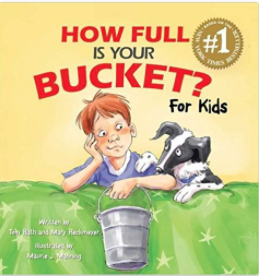
How Full Is Your Bucket?

Overview
Obtain and read the book, How Full is Your Bucket, (For Kids) by Tom Rath and illustrated by Mary Reckmeyer. Brainstorm a list of bucket fillers together to inspire acts of kindness in the community. The negative actions of others toward us can empty our buckets, and our own meanness toward them can empty their buckets, too. Positive actions will reverse the process.
Students can brainstorm ideas to help others in the community and address and potentially solve some of the issues. The teacher will use mind mapping tools with the students to capture thoughts and ideas.
This activity will take several class periods.
Learning Objectives
Students will:
- Be able to brainstorm ideas together to help others in need in the community.
- Understand what it is to help others in need.
- Be able to assume different roles e.g.,team leader, notetaker, researcher.
- Be able to address the need as a class.
Vocabulary
Vocabulary Words:
- Community: A community is a a group of people living in the same place or having the same things in common.
- Brainstorm: To brainstorm is to produce an idea or way of solving a problem.
Pre-planning
To prepare for this lesson:
- Read How Full Is Your Bucket by Tom Rath.
- Decide what type of brainstorming tool to use with the students as they brainstorm ideas for assisting those in need in the community.
- Contact ahead of time local agencies that provide assistance to those in need.
- Senior citizens
- Homeless
- Babies and toddlers
- Literacy
- Find a speaker from one or more of the agencies to come and speak to the children. You may also be able to Zoom or use Google Meet to meet with the speaker.
- Use a tool like Google Docs or Microsoft Office 365 with the students for planning. The teacher will project the document and the students will help fill it in.
- An option is to assign students to groups to plan the project implementation. This is a great time to begin teaching them how to work in teams and have a team leader, researcher, timekeeper, and note-taker.
Accommodations
See the Accommodations Page and Charts on the 21things4students website in the Teacher Resources.
Steps
Directions for this activity:
- The teacher will tell the students that they are going to brainstorm ideas for helping those in need in the community.
- The teacher will read the book How Full is Your Bucket to the students.
- The teacher will have the students brainstorm ideas for helping those in need in the community.
- The teacher will use a mind-mapping tool like Canva or Popplet with the students.
- The students will decide as a class which group to help and how they will help them.
- The teacher will use a tool like Google Docs or Microsoft Office 365 with the students to plan how they will implement the project. If the project is very small scale the planning can also be done in Canva or Popplet.
- The teacher and students will carry out the plan. Ideas could be to bring in canned food, baby items, books, etc.
Options For This Activity:
- Guest speakers can be invited from local agencies to discuss their needs with the students. The guest speaker can video conference using Google Meet or Zoom or come in person.
- Students can work on the project together in small groups and begin learning how to do group projects with roles assigned to them.
- Students themselves can use online tools if they have access to them.
Assessment Options
Different options for assessing the students:
- Observations
- Check for understanding
- Students participate fully whether they are in a large group or small groups.
MITECS COmpetencies & ISTE STANDARDS
MITECS: Michigan adopted the "ISTE Standards for Students" called MITECS (Michigan Integrated Technology Competencies for Students) in 2018.
Global Collaborator
7b. Students use collaborative technologies to work with others, including peers, experts or community members, to examine issues and problems from multiple viewpoints.
7d. Students explore local and global issues and use collaborative technologies to work with others to investigate solutions.
Devices and Resources
CONTENT AREA RESOURCES
ELA
Read other similar books to the students about bucket fillers and being kind to each other.
Social Studies
The students will learn more about the community that they live in.
CREDITS
This task card was created by Melissa White, 21 Things Project Manager, REMC Association, February 2018. Updated October 2023.


